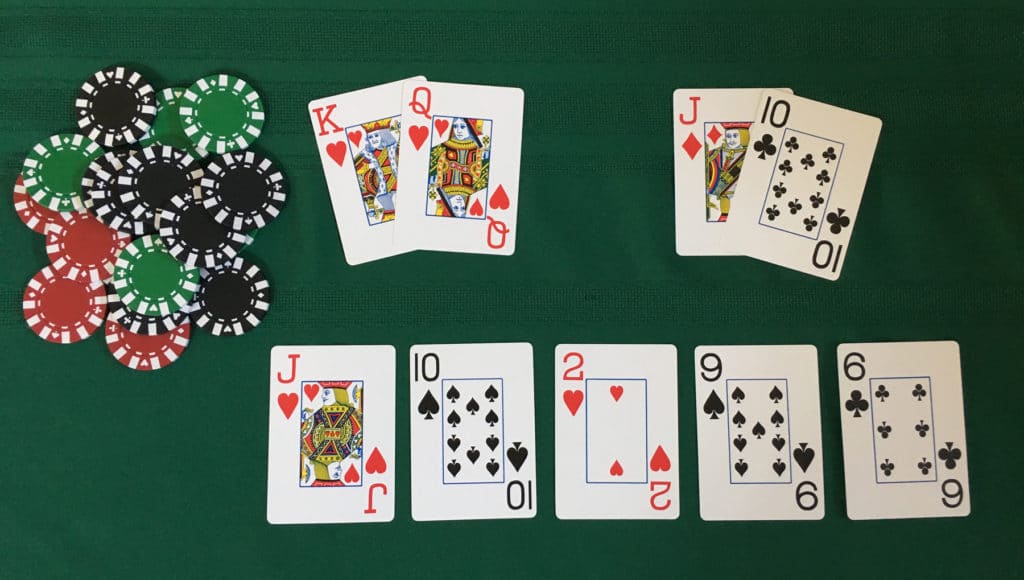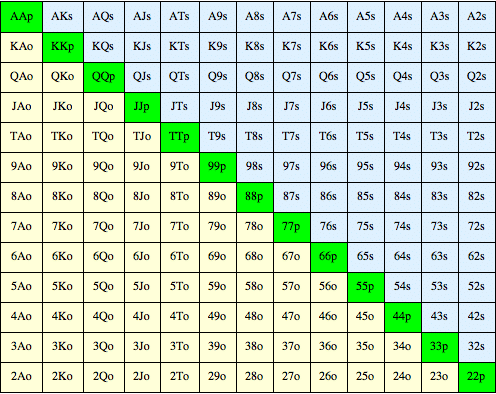Poker has been around for a long, long time. Over the past few years, thanks to training sites and other teaching aids, players have gotten better. A lot of the basic mistakes that almost everyone used to make have been erased, and are now few and far between. There is one thing that hasn't seemed to change, though, that I always see players doing that causes them to lose money and get exploited by better players. I'm referring to opting to limp into the pot pre-flop instead of coming in for a raise.
- Texas Holdem Preflop Chart
- Poker Hands To Play Preflop
- Texas Holdem Preflop Strategy
- Texas Holdem Pre Flop Charts
- Texas Holdem Preflop Rules
Online Poker » Poker Strategy » Texas Hold Em » Pre Flop Play Preflop play in poker is generally the easiest stage of the game. You are dealt your hand and there are 3 decisions as to what to do with it - you can call, raise or fold. Limping pre-flop in Texas hold'em may seem like a way to see cheap flops, but it may be having a disastrous effect on your profits and success in the game. Safe & Secure Fast Payouts. Jan 13, 2021 Some of the most important decisions you will make in a Texas Hold'em hand happen before the flop. This means that one of the most important aspects of Hold'em poker occurs when you have the least amount of information about the hand.
Now, before I dive into this, I want to throw out a disclaimer. There are some new schools of thought that advocate mixing in some limps early in tournaments, some on the button, and some in the small blind. For the most part, though, limping into pots as the first one in pre-flop is going to be a losing play. I'll cover these special situations as well, just to be fully inclusive.
Here's what you can expect to learn from this article. I'm going to talk about the reasons that you want to raise pre-flop instead of limp, how it can give you more ways to win, and also how to exploit players who are limping into pots too often. While this may seem like a simple concept, understanding the reasoning behind it will help your game immensely. It also may open your mind up to some new ways that you can play hands creatively to win more pots.
A Quick Definition
Texas Holdem Preflop Chart
Before I get rolling, I want to make sure that everyone is on the same page. I want to make sure that you're clear on what limping is and what it is not for this discussion. A limp, by definition, is when you just call the blind pre-flop. You don't put in any additional money, and no one else has raised the pot. If you just call a pre-flop raise, that is not a limp. That is a call.
When I discuss limps today, I'm going to be referring to limping when you are the first one into the pot. I think that limping after several other people have limped is ok and should not be included in this discussion. I'm only talking about the times that no one else has entered the pot and you are the first one in and you just match the big blind.
Limping after a bunch of other people happens sometimes, and can allow you to see pots for cheap. Be careful, though, as your opponents can have literally anything. Make sure not to lose all of your chips in a limped pot without the stone-cold nuts. The whole 'There's no way he could have a 2 here!' stuff goes right out the window in limped pots. Anyone can have anything, and you need to be aware of that.
Multiple Ways to Win the Pot
The reason that raising pre-flop is so important is that it gives you more than one way to win the pot. If you raise pre-flop and everyone folds, you pick up the blinds and antes. This isn't possible if you just limp in. If you raise pre-flop and get called, and then elect to continuation bet the flop when you miss, your opponents might fold, and you'll win the pot. This isn't possible if you just limp in. No one will give you credit for the continued aggression. No pre-flop raise is not consistent with a big hand. Your story won't make sense.

By taking the lead in the pot, you're the one who gets to dictate the action and who has the better chance of picking up the pot when no one hits the flop. If you haven't checked out my guide to continuation betting, you definitely need to take a few minutes and read through it.
Controlled aggression in Texas hold'em will always be rewarded over being passive. When you limp into the pot, you only have one good way of winning the pot. You have to hit your hand to win the pot. Otherwise, your only option is to bet and just hope that everyone else folds. Trying to crank on the aggression after limping in pre-flop isn't going to make a lot of sense and won't get a lot of respect from the other players. You will also be completely guessing, which is what the next section is dedicated to.
Stop Yourself from Guessing
When you raise pre-flop, you begin defining your opponent's ranges. You know what hands they call raises with from what positions, and you know what hands they fold to raises from what positions. Even if you've never played with an opponent before, you can have a decent idea, based on basic strategy, what they are playing to a raise. For example, if you raise pre-flop from early position, you can usually assume that your opponent isn't playing a hand like 2-4 suited from the positions right behind you. Yes, some might, but most people aren't.
This means you can rule out hands like this from their range if they call your raise. If you limp in, though, you'll have no idea what your opponent is holding if they just limp in too. Maybe they are getting froggy and want to see a cheap hand with a speculative one like this.

By taking the lead in the pot, you're the one who gets to dictate the action and who has the better chance of picking up the pot when no one hits the flop. If you haven't checked out my guide to continuation betting, you definitely need to take a few minutes and read through it.
Controlled aggression in Texas hold'em will always be rewarded over being passive. When you limp into the pot, you only have one good way of winning the pot. You have to hit your hand to win the pot. Otherwise, your only option is to bet and just hope that everyone else folds. Trying to crank on the aggression after limping in pre-flop isn't going to make a lot of sense and won't get a lot of respect from the other players. You will also be completely guessing, which is what the next section is dedicated to.
Stop Yourself from Guessing
When you raise pre-flop, you begin defining your opponent's ranges. You know what hands they call raises with from what positions, and you know what hands they fold to raises from what positions. Even if you've never played with an opponent before, you can have a decent idea, based on basic strategy, what they are playing to a raise. For example, if you raise pre-flop from early position, you can usually assume that your opponent isn't playing a hand like 2-4 suited from the positions right behind you. Yes, some might, but most people aren't.
This means you can rule out hands like this from their range if they call your raise. If you limp in, though, you'll have no idea what your opponent is holding if they just limp in too. Maybe they are getting froggy and want to see a cheap hand with a speculative one like this.
While you won't have all the information just by raising pre-flop, you're going to have a significant amount more than if you had just limped in. The name of the game is defining your opponent's range as much as possible. The more you can do this, the better decisions you can make.
Poker Hands To Play Preflop
Exploiting Limpers
I want you to look at this section from both sides. I want you to look at it as a warning to prevent you from being exploited, but I also want you to look at it as a possible way that you can start exploiting people that are limping into pots too often.
The term for what I'm going to talk about is isolating. Isolating is a broad poker term with several different meanings. Here, though, I'm going to talk specifically about isolating limpers. Let's look at an example.
Let's say an opponent limps into the pot from the cut off, and you're on the button with 9-10 suited. Most people in this situation would be tempted to limp behind their opponent and take a cheap flop and try and make a hand. When you limp, the small blind will probably complete, and the big blind will most likely check. You'll be going to the flop four ways when the only way you can realistically win the pot is by making your hand.
But what happens if you decide to raise here? Let's say that you come in for a raise. The small and big blind decides to fold, and then the action is back around to the limper. Two things can happen. First, they could fold as well, and you'll scoop a small, but nice pot. That's a win. The second option is that they could make the call and you take a flop. This might sound bad, but it's actually a pretty awesome situation.
You're now building a pot in position against a weak hand and a passive player. Your perceived range is also very strong, meaning that you can continuation bet a lot of strong flops. Let's say the board comes out A-8-4. Your opponent checks, and you fire out a continuation bet. You're going to win this hand most of the time, because your opponent is rarely going to have an ace here, but based on the pre-flop action, you're supposed to have one quite a bit.
The only situations where they might have an ace is if they have a weak suited ace that they limped in (or if they limp 100% of their hands). In these situations, you can usually get them off of their hand with a healthy turn bet. The point is, though, you're going to be able to take down the pot a lot on the flop when your opponent misses.
Here's the fun part of this oneTexas Holdem Preflop Strategy
You can do this over and over again to the same player and rarely will they know how to react properly.
This either means that they're going to react incorrectly and make a huge mistake or they're not going to react at all, and you can keep doing it to them over and over again. Members of our staff say they've sat and done this to the same fish for hours without them as much as batting an eyebrow. They're so consumed with their own cards and what they have, that they neglect to notice what is being done over and over again.
The next logical question is what hands should you be doing this with and what hands should you be limping behind with. First, if you have a big hand, you should be raising. This is a no-brainer. Second, if you're in late position with a pretty good hand, you should be looking into raising, especially if your opponent has a propensity to limp with very weak hands. If you're going to have a stronger hand than them most of the time, you should work to take control of the pot.
You can also mix in doing this with weaker and more speculative hands, like suited connectors and pairs. This will help to keep your range balanced and your opponents guessing. Take note, though, if you have to go to showdown with one of these marginal hands. Your opponents may or may not take note of this and may look to take advantage of you. They may look to start limping big hands to trap you, or someone behind you may look to 3-bet you pre-flop if they want to go to war and think you're getting too splashy.
For the most part, though, the limping fish never pay attention and never notice what's going on. For them, as soon as the hand hits the flop, they forget about pre-flop. The same is true with every street where at the end of the hand all they remember is what happened on the river. If you're playing against a passive fish who refuses to fight for pots, you may want to look to really open up what you're isolating them with.
The idea of isolating is that you ideally want to get heads up with the fish with everyone else out of the pot. You should be doing this from in position mostly because you can then work a positional advantage against the fish, even if you have a weaker hand. We recommend occasionally limping behind, and if you're playing live drawing attention to it casually. The fish will then start to incorrectly think that you're only raising them when you have big hands. You can keep this charade up until you have to showdown something weak. Even then, they might not notice, as we noted earlier.
Just be careful that any strong players acting behind you don't catch on to your games and start to mess with you. In my experience, they'll usually leave you alone if you don't attack the fish every single hand. If you let them get some work in as well, they'll usually leave you alone.
To close this section, there are two things that I want you to take away. First, make sure you aren't limping and allowing people to isolate you and bully you out of pots. Second, look for opportunities where you can take advantage of passive players that aren't coming in for raises pre-flop.
When It's Ok to Limp
As I mentioned in the intro, there are a few situations where some people would argue that limping is ok. First, when several other people have limped into the pot, it can be ok to limp as well. There's no reason always to be the person spoiling the party. Don't be scared to ruin the party when it's right, but it's ok to mix in seeing cheap flops every now and then.
Lately, I've been seeing more top pros limp into pots pre-flop early in tournaments. While it's up to personal preference whether you do this or not, some will argue that it helps to balance things out and allows them to limp big hands later.
Texas Holdem Pre Flop Charts
I also have seen some people starting to limp on the button some later in tournaments. This can be effective as a non-threating approach to winning pots where most people will not fight you if they miss the flop. It's also so out of the ordinary that most people without a big hand will run for the hills out of sheer confusion. Some players do this quite a bit, while others only limp it in occasionally.
The last instance that I do see it is from the small blind when everyone else folds. Some top-level pros are limping 100% of their range from the small blind and employing an interesting strategy after that. While I won't go into blind versus blind at this point, just be aware that a lot of the things discussed here do not apply to the blinds.
Texas Holdem Preflop Rules
Putting It All Together
For those of you that read through this whole article, I hope you got a lot more out of it than you expected. Sometimes concepts that you think are simple have a lot more to them when you start to break them down. Understanding every situation in poker to the fullest is key to being a great player.
Limping pre-flop might seem like a relaxing approach to the game, but the passiveness is probably affecting your bottom line. Make sure you're not allowing yourself to be a target of the sharks and allowing them to take advantage of you. On the same token, you need to take on the role of the shark and look for opportunities to exploit people that haven't had the privilege of reading this article.

